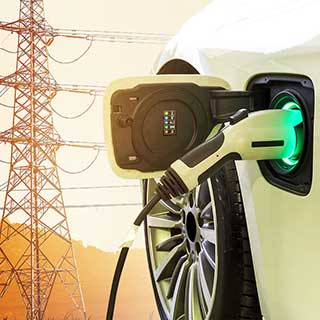How DISCOMs can Plan the Future for Electric Vehicles


Electric Vehicles (EV) is good news for DISCOMs
The increasing energy demand across the globe, coupled with the growing concerns of carbon emissions from the transport sector, has paved way for developing alternative energy options for mobility. The adoption of EVs is in nascent stages in India and is expected to proliferate with the right policy support in the next decade. EVs present numerous opportunities along with challenges in its interface with the power grid, which is part of Vehicle-Grid Integration (VGI). VGI refers to the many ways in which a vehicle can provide benefits or services to the grid, society, the EV driver, or charge point operator by optimising plug-in electric vehicle interaction with the electrical grid.
Every EV is an additional electricity consumer for a DISCOM and VGI is, therefore, a critical subject from the perspective of grid management. EVs are, in fact, good news for DISCOMs as it serves as an additional chance to sell more electricity and increase revenue. The most challenging part of EVs lies in the inability of DISCOMs to predict and control the charging.
 Figure 1 Impact of EV charging on load curve
Figure 1 Impact of EV charging on load curve
EV charging: transforming a problem into solution
The primary responsibility of DISCOMs is to supply reliable electricity to the end user. The stability of the grid and reliability of power could be compromised if several EVs are connected to the grid at the same time, causing the grid to overload. The problem gets worse at times when the grid is already experiencing a peak demand, and in locations where the network is already experiencing congestion. However, the grid experiences peak demand for a relatively lesser period of time, and with good VGI strategies, it is possible to supply power to EVs with minimal impact.
DISCOMs will therefore be interested to adopt smart EV charging in a way in which peak loading conditions could either be avoided, shifted or delayed. If the charging is managed properly, EVs could effectively contribute and assist DISCOMs in managing the distribution network in an efficient and reliable manner.
EV is a grid resource
EVs are not only a cleaner mode of transport but also considered a valuable grid resource as they offer dynamic battery storage as a flexible load. There are two pathways to VGI: V1G and V2G. V1G, also called smart charging, is the strategy to control the rate of charging of EVs. With bidirectional charging (V2G), EVs could also participate in grid management services. VGI enables EVs to participate in balancing the grid in real-time, and operating as generation/demand assets for grid operators (DISCOMs). Furthermore, VGI could also facilitate ancillary services like frequency regulation, voltage regulation, and reliability improvement. To unlock potential benefits of EVs, the first step DISCOMs need to take is to realise EVs as a grid resource.
Role of DISCOMs in EV aggregation
A small number of EVs at a given location is not sufficient to act as a grid resource. Hence, aggregation of EVs is essential to attain a minimum threshold for enabling their participation in the market. DISCOMs play an important role in the aggregation of EVs and the regulatory changes are necessary to provide clarity regarding the same. There are four potential aggregation models with different levels of DISCOM participation:
- DISCOM as the sole aggregator: in this model, DISCOM as the only aggregator would be responsible for ensuring customer participation and would have control over EV charging or discharging. This would allow the DISCOM to gain detailed knowledge of EVs and their respective travel behavior, which will be utilised to efficiently manage and operate the distribution network. The downside of this model is that it will create a monopolistic market without competition, which could limit innovation.
 Figure 2 DISCOM as the sole aggregator
Figure 2 DISCOM as the sole aggregator - DISCOM as a meta-aggregator: in this model, DISCOMs and other third-party aggregators can coexist. These third-party aggregators will act as an intermediary between the consumer and the DISCOM. In this case, the DISCOM will not have direct interaction with the EV user, and the aggregator(s) will not directly participate in the EV market. A limitation of this model is that it might reduce competition in the wholesale market, leading the aggregators to entirely rely upon DISCOMs for their compensation benefits. This is the reason why regulatory interventions are needed to ensure that aggregators are properly compensated, and the resources are used in an efficient manner.
 Figure 3 DISCOM as the meta-aggregator
Figure 3 DISCOM as the meta-aggregator - Competitive aggregation without DISCOM participation: In the case of a competitive aggregation market without active participation from the DISCOM, third-party aggregators are responsible for aggregating EVs to offer services to the DISCOM or participate in the markets. For aggregators to provide services to the DISCOM, the DISCOM needs to develop price signals that reflect the costs and benefits of EV charging and grid services. A medium to communicate these price signals to aggregators and customers is also required. Realising DISCOM benefits and allowing third-party wholesale access to the EV resource would require regulations that allow these two entities to coexist.
 Figure 4 Competitive aggregation without DISCOM participation
Figure 4 Competitive aggregation without DISCOM participation - Hybrid Market: the hybrid market approach allows DISCOMs and third-party aggregators to compete with each other for customers, rather than restricting the involvement of DISCOMs and other actors. In such a scenario, a regulatory framework is necessary to enable all these entities to compete on a level playing field and maximise opportunities to reap both wholesale and distribution benefits.
 Figure 5 Hybrid Model
Figure 5 Hybrid Model
Regulatory changes are the need of the hour
It is evident that DISCOMs play a major role in VGI, depending on the business model adopted. A prerequisite for VGI implementation is appropriate price signals for electricity. The first and most simple step in providing appropriate price signals is implementing Time of Use (ToU) electricity rates. With ToU, EV users can be encouraged to shift EV charging to off-peak hours or surplus renewable generation hours. Another challenge to implementing VGI in India is the lack of a market-based mechanism for ancillary services.
While there are several regulatory provisions in India that are supportive of VGI, there are also certain major gaps in the existing regulatory framework that warrant action. A key gap is the lack of provision for third party aggregators to participate in for resource aggregation. Existing Indian regulations lack provisions that permit aggregation of distributed energy resources in general, including EVs, to provide grid services. A potential solution would be to develop a model regulation on resource aggregation, which can define the role of DISCOMs to undertake demand aggregation in its area of supply.
For more details please refer to Vehicle Grid Integration: the new frontier for electric mobility in India
Written by Ishan Bhand, Research Consultant, Power Utility and Electric Mobility Vertical




